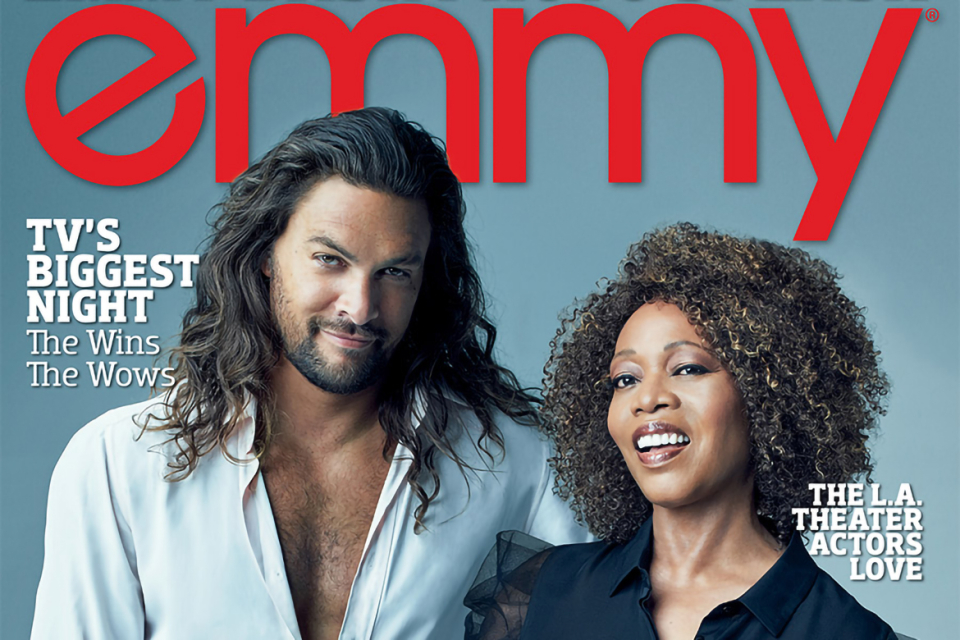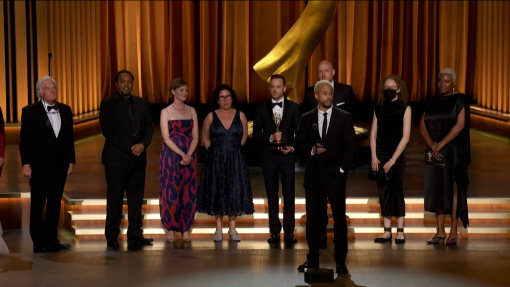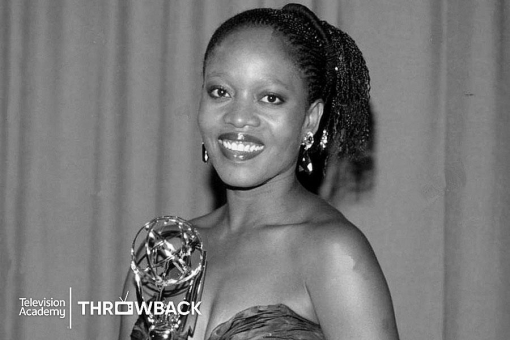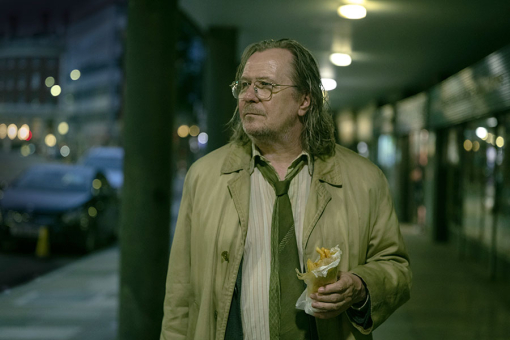It makes perfect sense that Apple would choose See to help launch Apple TV+, its new video subscription service.
Both the company and the drama series are all about exploring where our world is going, rather than where it's been. They're both epic on a scale far beyond most of their competition, and ultimately, they're both about vision — though in See's case, how humans compensate in its absence.
In the world of this 10-episode series, set 600 years in the future, a deadly virus has reduced Earth's population to a mere 2 million, while robbing all humans of sight. Survivors rely on their other senses to live off the land and build a new, technology-free civilization. Warring tribes struggle, and in the midst of all this, two babies are born with the ability to — yes — see.
Led by Baba Voss (Jason Momoa), the children's father, and his sage, Paris (Alfre Woodard), a group of survivors goes on the run to protect the children from those who pursue them. See — debuting, like the service, on November 1 — comes from creator–writer–executive producer Steven Knight (Peaky Blinders) and director–executive producer Francis Lawrence (The Hunger Games franchise).
While it wasn't the first series in development at Apple TV+, the company immediately realized See fit the blueprint for the sort of programming it wanted.
"One of the big words we use at Apple is humanity ," says Zack Van Amburg, who — along with Jamie Erlicht — heads Apple's worldwide video programming. "This really is a company that at its core believes deeply in humanity. So when we listen to pitches, we ask, 'How and where does humanity show up in this?'
"And when you pull that thread through See, you have questions like, 'If we had no sight, would we behave differently? Would social interactions feel different? Would any sort of prejudice or racism be absent?' The pitch asked big, interesting questions and we thought, 'If they were able to execute that with humanity at its core, this could be unlike any other post-apocalyptic project you've ever seen.'"
Erlicht adds: "When 99.99 percent of the population is no longer there and the world is more tribal, would we actually be more connected to each other than we have been in hundreds of years? That flip was really interesting to me. And that's why I think See has parallels to modern times.
"When something new arrives to threaten the status quo, what will happen to that status quo? In that journey is an epic, world-building adventure. Can it be as epic as, say, a Game of Thrones? We answer that question early on with a resounding 'yes!'"
Since moving to Apple in 2017 from their roles as presidents of Sony Pictures Television, Erlicht and Van Amburg have listened to a steady stream of pitches and greenlit some two dozen series and films for Apple TV+. Most come from some of the biggest names in entertainment, like Jennifer Aniston and Reese Witherspoon, Steven Spielberg and Oprah Winfrey.
At first, though, Momoa and Woodard were reluctant to lend their names to that list.
Woodard, a four-time Emmy winner, mock-admits that the show's futuristic premise presented a problem.
"I'm not signing up for a series where I have to wear a unitard," she says, smiling. "I figured that somehow they've determined everyone in the future wears unitards, and I'll have to hold in my weight playing the part for the next five years. But I'm also a big Steven Knight fan, so when I knew he was doing this, I signed up."
Momoa had just finished working on the Netflix series Frontier and was traveling by train in England when he first saw Knight's script. "My agent said he was going to fight for me to get the role and I needed to read the script right away," the Aquaman star recalls. "I was so blown away by the first three pages, I read them out loud to my two best friends, who were with me. It's the first time I've ever done that with a script.
"I was like, 'Get me that meeting! Get me that role!'" He was intrigued by the idea of playing a father for the first time, and by the massive battle scenes that "have you on the edge of your seat from the get-go." However, the real thrill for both actors came from the idea that they'd have to learn how to operate in a world they'd literally never seen before.
For Lawrence, that meant everything from sets to costumes to blocking had to be completely reinvented. Which is why, even before starting production in the mountains of British Columbia, he and Knight set up "think tanks" with blindness consultants, evolutionary biologists and even survivalists to determine the look of this new world.
Those discussions led to ideas like the creaky floor in the home of the show's villain, Queen Kane (Sylvia Hoeks).
It was inspired by a visit Lawrence had once made to a palace in Kyoto, Japan, where a shogun had been so paranoid about assassins that he made sure the floor creaked to alert him if anyone was nearby. Such physical innovations were important, but adjustments in how the actors moved and spoke to one another were equally critical.
"We were constantly reinventing," says Lawrence (the series' other executive producers are Peter Chernin, Jenno Topping, Kristen Campo, Dan Shotz and Jonathan E. Steinberg). "It was a learning process for everyone, learning how to move without relying on sight.
"Jason was a prime example. Navigation was a big part of the show, and he was constantly devising new ways to move. He might be wearing a long robe and throw it out almost like a whip in front of him to guide him. Sometimes he might be carrying an axe, and he'd slide it out in front like a walking stick. If he was walking by water, he'd kick some so others could follow the splash."
Before production began, Lawrence also organized an actors' orientation. Low-vision consultants put the performers through hours of exercises to teach them to rely on senses other than sight when moving. One required wearing a sleep shade.
Woodard recalls how within two minutes of slipping it on, she "got giggly and hyper — after 10 or 15 minutes, I had to stop. It overwhelmed my other senses. It was as if my nervous system was moving like a lawn sprinkler — pow, pow, pow!"
Ultimately, the training was like "learning a new language," she says. "It was really exciting and eye-opening, so to speak, to experience the world in a different way. It offered the tiniest little window into seeing the world in a way like that of our brothers and sisters who have compromised vision."
One adviser she worked with was associate producer and blindness consultant Joe Strechay, who was equally impressed with how open the sighted actors were to suggestions. For instance, he noticed that Momoa was fond of wearing an outfit with a hood, but for a blind person, a hood can restrict hearing and thus the ability to get around. Momoa gave up the outfit.
"He learned very quickly how much his actions mattered to [low-vision and blind] people," says Strechay, who has consulted on other shows, including Netflix's Daredevil. "Jason brought so much heart to the production, and Alfre as well.
"She had a list of questions for me. She talked a lot about emotions and facial expressions, and I explained that some of how we express ourselves in our face is learned visually, and she really wanted to play with that idea."
The production employed dozens of low-vision and blind actors for a variety of roles, from leads to background, and Lawrence says he was constantly relying on their input to make every scene as realistic as possible.
For instance, when shooting a scene that involved nearly 100 characters moving down a steep hill before a battle, he stopped filming to consider suggestions that Momoa and his tribe should move more slowly and lower to the ground. Lawrence hopes viewers will appreciate those moments of realism.
"It's a significant idea for audiences to get," he states. "One of my fears is that people will underestimate the abilities of people without sight — that they will see actors in the show and think, 'Those people can't do that,' but I guarantee you, they can."
Developing a series that showcases performers who are seldom in the spotlight may not have been a specific goal when Erlicht and Van Amburg ordered See, but according to Apple CEO Tim Cook, the show's inclusive approach is a perfect metaphor for his company's leap into television.
Apple "wanted our products to be used by everyone," he says. "That's deeply embedded in the company and how we think about life. So that's an incredible intersection."
At a promotional event in March, the intersection of high-wattage talent was indicative of the company's ample resources and vast ambition. Momoa, Woodard, Spielberg and Winfrey were among the big names gathered at Apple's Cupertino, California, headquarters to announce their new shows.
Subsequently, though, the company remained quiet, finally revealing details in September; Apple TV+ will be available for $4.99 per month, with a seven-day free trial; customers who have purchased an iPhone, iPad, Apple TV, iPod Touch or Mac since September 10 can receive one year of Apple TV+ for free, and up to six family members can share a subscription.
Most series will premiere with three episodes, with one new episode to drop each week thereafter; full seasons of some series will be available all at once.
Besides See, original series debuting November 1 will be The Morning Show, Dickinson and For All Mankind, as well as the documentary The Elephant Queen and an Oprah Winfrey series that, at press time, had not been titled. Children's series launching the same day will be Helpsters, from the makers of Sesame Street, Snoopy in Space and Ghostwriter.
Subsequent launches will include Servant, a psychological thriller from M. Night Shyamalan; Truth Be Told, a drama starring Octavia Spencer and Aaron Paul; Little America, an anthology of immigrant stories from executive producers Kumail Nanjiani and Emily V. Gordon; The Banker, a feature film starring Anthony Mackie and Samuel L. Jackson; and Hala, a film about a Muslim teen that was an official selection of the Sundance and Toronto film festivals.
Erlicht and Van Amburg, who oversaw successful shows like Breaking Bad and The Crown while at Sony, acknowledge the differences of their new environment.
"People warned us before we started here that we were going into a different culture," Erlicht says. "It was tech culture, and we weren't going to fit in. That's absolutely not the case. It is a unique culture, but we've embraced so much of it. That was important to us because, for the last many years, Apple culture has defined all of culture. So it'd be hubris to think we could do it differently or better."
They know that Apple's success in creating viewing devices doesn't guarantee success in a streaming world already teeming with competitors; Amazon Prime Video, Netflix and Hulu will soon be joined by Disney+ and HBO Max. Erlicht says Apple TV+ will stand out because it relies more on television alchemy than on algorithms.
"Unlike a lot of platforms and networks that build scheduling boxes based on, 'We need six of these and three of those and two of those,' we have conversations about our shows," he says. "It's about, 'How excellent is this one idea?' So with See, for example, I can't say our decision to move ahead was informed by whatever we'd decided before or after. The decision just lived on its own."
Van Amburg says shows were ordered regardless of who pitched them.
"What's different about this place from anywhere we've ever been is that we did not say yes to any of these shows and movies based on the amazing auspices behind them or the incredible actors in them. We said yes because these ideas were fundamentally great, and the great actors, directors and producers gave us the confidence to say yes — and [to say it] more rapidly.
"Their experience made us feel more comfortable faster. But this isn't a place that's decided to play it safe or name-collect."
In Momoa's view, that attitude helps those working on Apple shows feel "like a first-born child — we're really loved and protected."
That's not a typical TV experience, adds Woodard, who recalls working "for networks and studios where you get notes from the top of the chain about whether my hair should be curled or blown straight or what color my dress should be. And I just think, 'You hired people for that — don't micromanage what you think people want to see. That's our job. We do that.'
"Apple doesn't know the rules to be beholden to, and that's really refreshing."
Of course, there's a certain pressure that comes with making one of the first shows from a high-profile company that has never done this kind of thing before. As far as Lawrence is concerned, that stress was one of the main reasons he wanted to work with Apple.
"With so many shows coming out all the time, you worry about how you're going to pop. I knew being part of the first batch of [Apple TV+] series meant there are going to be eyes on this. Plus, the idea of being a part of this wild, wild west with a company that doesn't have a set of rules is kind of fun."
That excitement and opportunity have Van Amburg and Erlicht confident that shows like See aren't just quality television — they also offer a glimpse into a new way of making television.
"We want people to feel like when they come here and deliver the right show, it's a bit of a golden ticket," Erlicht explains. "We're building a service on the back of quality originals. To do that, you have to be a bit more discerning, a bit more patient. If you come to us with something good and we don't feel there's a path to make it great, we need to let that one go.
"That'll give you slight second thoughts when it goes to a competitor," he admits, "but you put that out of your mind. Because when the next one comes in that is great — or on the path to being great — you realize you've made the right calls."
Go behind the scenes of emmy's cover shoot with Alfre Woodard and Jason Momoa at TelevisionAcademy.com/cover.
This article originally appeared in emmy magazine, Issue No. 10, 2019


















